As described on other pages, the energy storage capabilities of compressed air are rather limited. See compressed-air vehicles. About the least suitable application is the propulsion of aeroplanes, where the need for a large and strongly-built reservoir is a crippling drawback. Nonetheless, in the very earliest days of attempted aviation, it was tried several times, for want of anything better. Faute de mieux, as the French say, though for some reason that always makes me think of mustard.
Interest in compressed-air propulsion died rapidly when internal-combustion engines became practical.
Since the Lilienthal engine actually ran on carbon dioxide rather than air, it has been moved to the carbonic acid engine page.

THE TATIN COMPRESSED-AIR MODEL PLANE: 1879
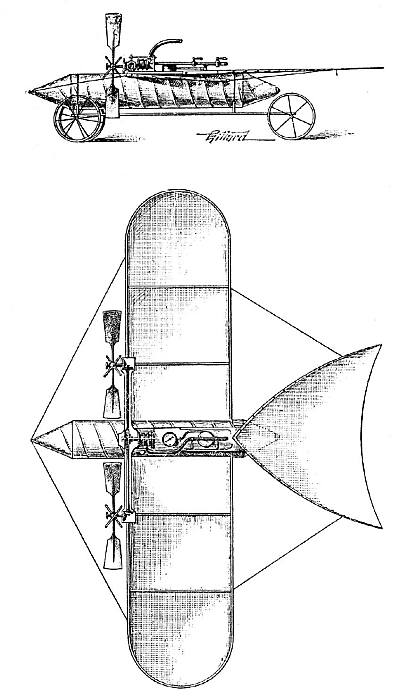 |
| Left: The Tatin compressed-air model plane of 1879
In 1879, M Victor Tatin built a twin-propellor model aeroplane weighing 1.75 kg, powered by compressed air.
The main body of the plane was a cylindrical reservoir filled with air, fitted with conical caps at each end for streamlining, and apparently having some sort of spiral reinforcement. The air reservoir had a capacity of 8 litres, and is quoted as resisting a pressure of "20 kg", which presumably means 20 kg per square centimetre, equivalent to 284 psi.
The plan view shows a centrally mounted compressed-air motor coupled to the two contra-rotating propellors by a transverse shaft and bevel gearing. A pressure gauge can be seen just behind the motor. The construction of the motor is currently unknown.
The model is reported to have taken off when its forward speed reached 8 metres per second (18 mph), and it was flown successfully in circles, tethered to a central point, at the military establishment at Chalais-Meudon in 1879. It circled at about head height. The duration of flights was not reported.
It is notable that this model has quite a modern look, considering it was built 24 years before the Wright brothers flew in 1903. Note, however, that there appear to be no control surfaces; Tatin had not solved the problem of controlling an aeroplane in flight; and his model was probably only stable because it was tethered.
In 1890 Tatin and his associate Charles Richet went on to build a larger model steam-powered aeroplane model with a 6.6 metre wingspan and weighing 33 kg, which made at least one short flight.
M. Tatin has a Wikipedia page.
From La Navigation Aérienne by Le Cornu. Pub by Librarie Nony & Co, 1903
|
 |
| Left: The Tatin compressed-air model plane of 1879
Here is Tatin's original model aeroplane, photographed at Musee de l'Air et de l'Espace, north of Paris.
The compressed air engine is the small brass cylinder on top of the air tank. It drives two horizontal shafts that turn the two propellors through bevel gearing.
|
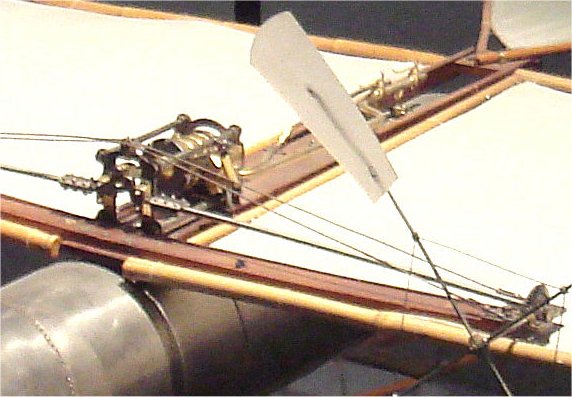 |
| Left: The Tatin compressed-air engine of 1879
Zooming in on the compressed-air engine, it looks as if it has a single oscillating cylinder with a crank coupled to the horizontal shafts in a very Meccano style. It is not known if it was single or double-acting. There appears to be a brass pipe running backwards to valves on top of the air tank.
|

CHANUTE, HERRING AND COMPRESSED AIR: 1898
The civil engineer and aviator Octave Chanute and his collaborator Augustus Herring used compressed air in their attempts at flight.
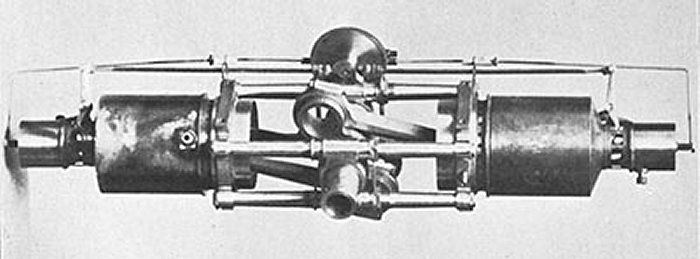 |
| Left: The Herring compressed-air motor: 1898
There are two horizontally-opposed cylinders; the smaller cylinders at each end presumably contained the inlet and exhaust valves, driven by push-rods from what looks like a geared-down camshaft just above the crankshaft. The small cylinders have slots which were the exit path for the exhaust air.
Maximum operating pressure was 500 psi.
|
Here is an account of Herring's first motorised flight in November 1898 at St Joseph, Michigan, as reported by the Chicago Record:
"Just above the lower surface of this is s small two-cylinder engine, weighing perhaps a dozen pounds, but which, if necessary, can develope 4 or 5 horsepower. This engine turns two five foot propellors, set parallel and situated one at the front and one at the rear of the machine. Below the engine is a small tank six or seven inches in diameter and about two feet long. This is filled with compressed air at a pressure of 500 psi, furnishing power to the engines..."
"Mr Herring crawled underneath the apparatus and raised it so easily it semed to possess no weight at all. A few forward steps were made, the engine shrieked and the machine leapt forward, an instant later sailing in free air, with the skids nearly a yard above the sand and the operator's legs drawn up in a bunch near the tank."
"It was really flying, already the machine covered a distance of 50 or 60 feet when the speed perceptibly slacked and a little farther on the apparatus came gently to rest on the sand. The distance covered was afterward measured at 73 feet and the time of flight was estimated by Herring at 8 to 10 seconds."
Chicago Record quoted from Fighter Pilot's Handbook - Magic, Death and Glory in the Golden Age of Flight by Gordon Thorburn.
While this was undoubtedly a brave effort, it does not meet the usual requirements of 'sustained, controlled flight'. Ten seconds can't really be called 'sustained' and the only control Herring had was by shifting his body weight. Just like Otto Lilienthal, who died as a consequence of inadequate control.
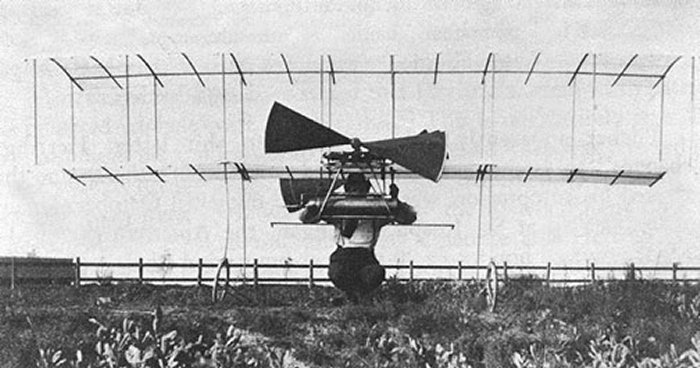 |
| Left: The Herring compressed-air biplane: 1898
Here the air tank can be seen just in front of the pilot. The engine appears to be just above his head, connected directly to the front and rear propellors.
|

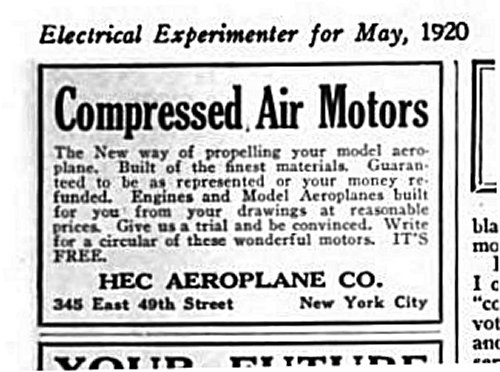 |
| Left: Advert for compressed-air model aeroplane propulsion: 1920
Regrettably vague, unfortunately.
Source: Hugo Gernsback's Electrical Experimenter for May 1920
|
 |
| Left: Advert for the HEC model aeroplane company: 1912
I expected to find that the HEC Aeroplane Company was unknown to Google, but I was wrong. This advert dates from 1912, so HEC were around for 8 years at least. Sadly there is no mention of compressed air for propulsion.
Source: Radio Amateur News (August 1919)
|
A company called Air Hogs makes compressed air model planes. They have a website
I was taken aback to learn that there is a conspiracy theory that jet aeroplanes are actually powered by compressed air: "...there is simply no room in which to store the tens of thousands of pounds of jet fuel!" The compressed air apparently costs nothing, so there is massive cover-up to make people think expensive kerosene is used and so accept high air-ticket prices.
You couldn't make it up. And I haven't.
Read more here.













